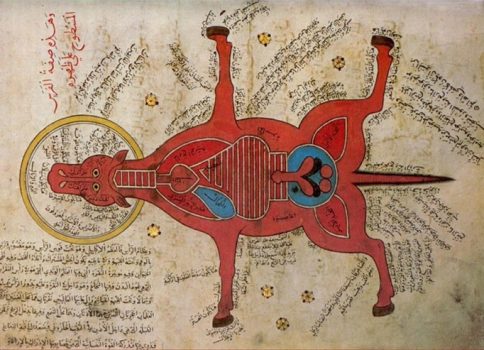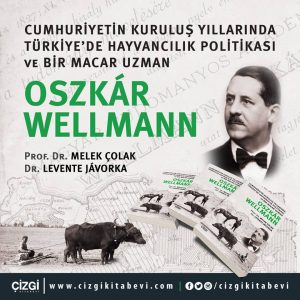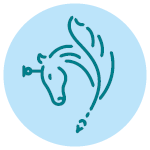
In the period between the 8th and the 13—15th centuries, the Islamic golden age, the knowledge of veterinarians was recorded in a series of manuscripts, so-called „baytarnames”. First these had been the Arabic translations of Greek, Persian, Syrian and Sanskrit works, but the collected knowledge was soon developed further on the bases of their experiences, experiments, and scientific approach. As a matter of course, the horse stood in the focus of the manuscripts the significance and beauty of which was praised in poetry, and much thought was devoted to its breeding, keeping, diseases and treatment. The copies of the manuscripts followed one-another and were enriched with new details, and knowledge from the field of etho-veteriary medicine.
The picture shows an anatomic image of a horse from a 84-page manuscript written in Arabic entitled The book of horse breeding, horse diseases and their therapy which can be found in the library of the Istanbul university. It was written by an anonymous veterinarian for the Mamluk general, az-Záhir Jalbáj in 1466, a good 130 years before Ruini’s Anatomia del Cavallo was published. According to a researcher of the manuscripts, Ferruh Dinçer the artistic value of the miniatures do not compete with the ones that can be found in the book by Ruini, however, the scientific content is of the highest quality.
For a long period following the golden era, the Osman Empire was characterised by internal and external fights for power. The efforts made for modernisation were not very successful in the 19th century, and it was only the military and political achievements of Kemal Atatürk that created the possibility for the establishment of the Republic of Turkey after World War I.
The young state introduced many achievements from abroad. In 1923 József Marek was invited to be the leader of the reorganized veterinary college of Istanbul – with no success. The development of animal breeding was also a part of modernisation. Oszkár Wellmann was asked to provide guidance in this, which is a proof of what can be read in his nomination for membership in the Hungarian Academy of Sciences: „He is an acknowledged, first class professional authority in the field of animal breeding as well,… whose opinion and advice is asked in all major affairs related to animal breeding, and who is effectively participating in all of such movements.” Wellmann, who did not want to leave the Budapest veterinary college for a longer period either, since he had become its rector, spent two times two months in Turkey during the summers of 1932 and 1933 respectively. He had visited the major studs and cattle and sheep breeding farms, and utilizing all his knowledge in genetics, and nutrition physiology, he elaborated proper programmes specifically fit for the local circumstances and needs. Let us not forget on the 75th anniversary of his death that „his excellence is acknowledged also abroad”.
Éva Orban
Acknowledgement: I am very grateful to Dr. Rahsan and Abdullah Özen, Veterinary Faculty, Firat University, for calling my attention to the wonderful ‘Baytarnames” and providing me with important literature on the subject.
Source of the image: http://muslimheritage.com/article/anatomy-horse-15th-century
Originally published in Hungarian: Orbán Éva: Lóminiatúra a 15. századból. Magyar Állatorvosok Lapja, 2018. 140. 5. 258.
Further reading: Çolak, Melek, Jávorka, Levente: Cumhuriyetin Kuruluş Yıllarında Türkiye’de Hayvancılık Politikası ve Bir Macar Uzman: Oszkár Wellmann. ISBN 978-605-196-070-8


